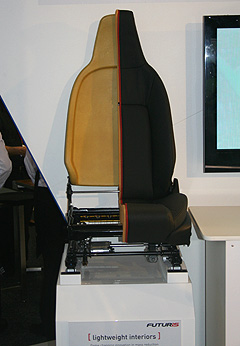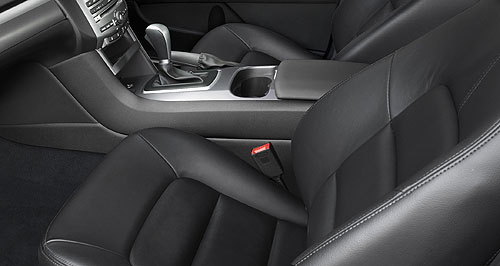Make / Model Search
News - General News - PartsAustralia develops plastic car seatShedding kilos: Futuris has developed a lightweight car seat that replaces traditional heavy, steel-framed pews. Top Aussie supplier Futuris has a clever new car seat design for global applications7 Jul 2011 By IAN PORTER LEADING Australian automotive component supplier Futuris has come up with a radical car seat that replaces heavy steel frames with a hollow plastic seatback made from strong synthetic fibres. The new seat promises to infiltrate a large proportion of the seat market, particularly at the small-car end of the market, with the potential to rack up large sales in emerging markets like China and India. And, in a major boost for the local parts industry, the new seatback can be made in Australia and exported around the world and still undercut traditional seat designs. The new Futuris seat has emerged at a time when all car-makers are feverishly working to pare weight out of their designs in a bid to cut fuel consumption and, therefore, reduce carbon dioxide emissions. Emissions and therefore weight reduction are now right up there with cost and styling as far as vehicle development priorities are concerned and car-makers are spending heavily on lightweight materials like aluminium and carbon-fibre. Futuris has teamed up with the Co-operative Research Centre for Advanced Automotive Technology (AutoCRC) to develop the radical new approach to stripping weight out of its car seats. Other participants in the research were the CSIRO, Deakin University, UniSA and Melbourne’s RMIT.  Left: A picture from the Futuris stand at the 2011 Australian International Motor Show. Left: A picture from the Futuris stand at the 2011 Australian International Motor Show.Speaking at a lightweighting seminar held by the Society of Plastics Engineers as part of Victoria’s Automotive Week, AutoCRC research manager Gary White said the patented seat design could save as much as 10kg a car. “Seating manufacturers around the world have been hitting a wall because the seat frame itself is generally made of steel, with a few cast components, perhaps,” he said. “With steel components, there is only so much you can do in reducing the amount of steel in the seat, simplifying manufacturing processes – spot welding is one way – and getting cost out before you start losing functions like lumbar support and active head restraints.” So what Futuris and the AutoCRC started with was the idea of a knitted seat, an idea Futuris patented in 2005. But it was not the outer layer or upholstery to be knitted, it was the seat back. This could be done using one of the modern synthetic threads on a conventional industrial knitting machine. Carbon-fibre has been tested, as have some aramids, which are threads similar to Nomex and Kevlar. All proved stronger than steel and Dr White indicated that one of the aramids might be the leading candidate. Once the seat is knitted, it is inflated in a mould in the exact shape required, infused with a setting agent and then cured into the designed shape. The finished item looks a bit like a misshapen surfing body board, but it is hollow inside and will have the seat padding added during assembly. At present only the seatback is being done as the bench part of the seat still needs to carry the means of adjustment like motors and hinges so the seatback can recline. Dr White said the woven seatback had passed all the parameters set down by car-makers, so it will perform at least as well as current seats in an accident. It emerges from the curing process with the required hard points to accommodate the fitting of hardware like latches and anchorage points. “The advantages include reduced labour content in the seat, reduced energy used in the process and low capital investment.” These advantages translate into low cost and low weight, which are major attractions for car-makers. “The big winner, though, is that you can choose to manufacture it anywhere. It can be shipped in a flat pack and moulded into shape near where it is installed in the car.” “The idea of being able to flat pack them and then assemble the seat structure close to the site overseas is pretty attractive.” The process of knitting the seat on an industrial knitting machine gives the seat-maker and the car-maker the ability to adjust the knitting to change the properties of the seat and better manage the deformation of the seat in a collision. Dr White said this could extend to the head restraint, eliminating the mechanical system that is used in a traditional seat. “It’s a low-waste process using only moderate heat and doing away with the autoclave process. It also eliminates labor in the lay-up process, the need for expensive tooling, heavy presses and welding.” Despite all the advantages, Dr White said there was one limitation: the Futuris seat may not be used in premium seats in the immediate future. “It will more likely be used in lower-cost applications because, with premium seats, one of the paradigms still is that you have to have multiple electrical actuators.” “Seat sets weight about 50kg per vehicle, and we will be saving around 10kg per car.” Reducing the weight of a vehicle offered the greatest potential for fuel savings, according to Heinz Hass, the manager of sustainability and environment at Ford Research and Advanced Engineering in Germany. Dr Hass said there were four main areas that offered the opportunity to cut fuel consumption: weight, aerodynamics, parasitic losses and rolling resistance. He said a 10 per cent reduction in weight would produce a three per cent gain in fuel economy, while a 10 per cent improvement in aerodynamics would yield a 1.4 per cent gain. A 10 per cent cut in parasitic loses would produce a two per cent gain while a 10 per cent reduction in rolling resistance would produce a one per cent drop in consumption. “It is clear that weight reduction offers the biggest potential for improvement in fuel consumption,” he told the SPE seminar. He said another way to look at the problem was to examine the different parts of a vehicle. He said a car is made up of the body (34 per cent), the powertrain (22 per cent), the chassis (20 per cent), the interior (16 per cent), the electrics (3 per cent) and the fluids (5 per cent). “The first four areas offer the most opportunity for weight reduction and that is where the focus is now.” He said the move to smaller, turbocharged engines was a natural way to pare weight down. “If you downsize a petrol engine from 2.0L to 1.6L, it leads to a downsizing of the transmission and the rest of the powertrain. In total, between 50 and 70kg can be saved,” Dr Hass said. He said more parts under the bonnet would be changed to plastic soon, including the sump, air ducts and even parts of turbochargers.  Read more |
Click to shareGeneral News articlesResearch General News Motor industry news |










Facebook Twitter Instagram